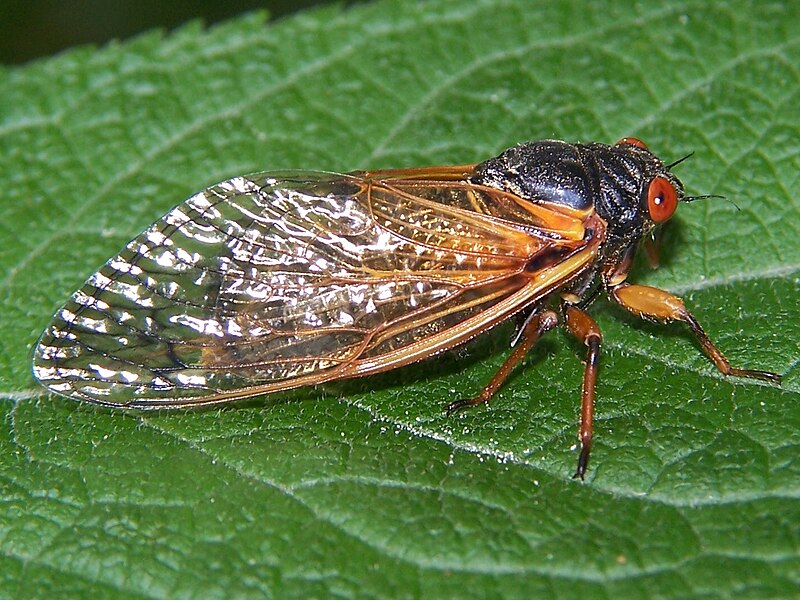April showers bring May flowers,
and, this year, some of the best topwater fishing of the century.
Following the annual transition into
spring, the Mid-Atlantic and Eastern Seaboard states are set to be blasted by a
tune so monotonous and otherworldly it can only be one thing—cicadas.
 Not to be confused with the less
intense “dog days” cicadas of the genus Tibicen
that emerge annually throughout late July and August, insects of the genus Magicicada are periodical emergers, and
have extremely long lifespans of 13 or 17 years. Physically, they can be set apart by their
milky-red eyes, black bodies, and golden wing cases.
Not to be confused with the less
intense “dog days” cicadas of the genus Tibicen
that emerge annually throughout late July and August, insects of the genus Magicicada are periodical emergers, and
have extremely long lifespans of 13 or 17 years. Physically, they can be set apart by their
milky-red eyes, black bodies, and golden wing cases.
Brood II cicadas, one of two
long-lived Magicicadas, which last
appeared in 1996, enjoy the longer 17-year life cycle, and are on schedule to
assail Virginians in 2013 when ground temperatures reach a consistent 64
degrees.
But where have these chirpers been
their whole lives? According to Chris
Asaro, forest health specialist for the Virginia Department of Forestry, “The
majority of the cicada’s life cycle is spent in the nymphal stage underground,
where it feeds on sap from tree roots.”
When they do emerge at full
maturity, the cicadas have only a few weeks of adult life, and have only one
thing on their minds—mating.
While it may seem that the
majority of nature’s rituals revolve around just that, it is none more loudly
evidenced than in the cicada. Over the
course of his 4-6-week adult life, the male engages in noisy courtship songs
that range up to 90 decibels locating mates.
After mating occurs, the female bores
small holes in the ends of twigs where she deposits her eggs in a process
called “flagging.”
Though most trees recover from
the nesting process, “flagging” is most often hosted by the more vulnerable newly-planted
fruit and ornamental trees. Those of you
with green thumbs: for prevention, fine
mesh netting is the recommended barrier—sprays are not.
Michael Raupp, University of
Maryland entomologist estimates that we could see densities of one billion
insects per square mile in Virginia. In
case you’re not a math person, that’s 40,598,000,000,000 throughout the state,
assuming equal distribution. The sudden
appearance of so many large, noisy, five-eyed, insects may create a bit of a
stir, but never fear, these harmless visitors are terminal, and only wish to
check off one important item from their bucket lists.
Crazy Topwater
So what does all this mean for
those of us with slimy thumbs? A billion of anything per square mile is sure
to inhabit water somewhere; and as water temperatures and ground temperatures
slide into the optimum ranges simultaneously, spawning fish are likely to look
to the surface for a skittering, larger-than-average meal.
Forget for a moment every
fisherman’s dream of casting in virgin waters.
Now consider the largemouth
bass. With an average life span of 10-12
years on the East Coast, even ranging to 16 years in Southern Texas, it’s for
certain that the trophy bass in your local pond or river have never seen an
insect pattern quite like what’s to kick off the summer of ’13. Larry will be hungry for cicada.
The same can be said for trout,
carp, catfish, panfish, and the pikes.
Even fish that normally wouldn’t take a surface lure will be drawn to
the swarming buffet up top.
What to Throw?
Keep lure choices small, and “match
the hatch” by keeping in mind the colors red, green, gold, and black. Arbogast’s Jitterbug and Hula Popper,
Heddon’s Crazy Crawler, and Rebel’s classic lures the Crickhopper, Bumble Bug,
and Pop-R in small sizes and the appropriate colors are all suitable imitations. Buzzbaits, jigs, spinnerbaits, and small
plastics in the same colors may also be worth a toss.
Imitating a cicada on the vise
will generally bond some combination of foam, deer hair, and rubber legs. As with any terrestrial pattern, buoyancy and
“bugginess” are key factors. Add bulk to
the equation and you’ve got a winning cicada pattern. If you need to, walk outside and snatch a
spent exoskeleton from the ground to imitate—there are plenty around. I will be experimenting here in the coming
weeks, so check the blog and Facebook page to borrow or share patterns!
If you’d prefer to buy flies, consider
hopper and cricket patterns in the larger sizes. Humpys and unweighted muddler patterns dabbed
in flotant may lend a hand too. Still,
most traditional dry fly patterns lack the proper bulk, so tying your own may
be the best option.
At the time of this writing, the
local ground sits at 62 degrees. We are
soon to be in the middle of the biggest cicada hatch since 2004. Get ready for some great topwater action, and
make it a spring to remember!
Originally published in The Rural Virginian

No comments :
Post a Comment